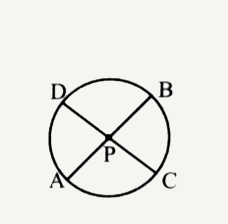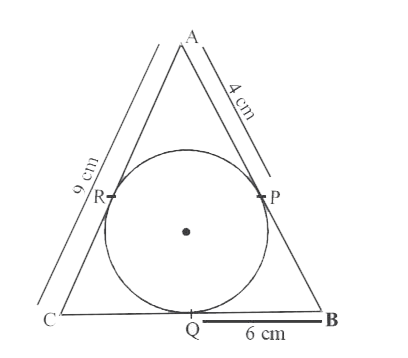In the given figure, AP = 3 cm, BA = 5 cm and CP = 2 cm. Find CD :

12 cm
10 cm
9 cm
6 cm
The correct Answer is:B
Step by step video, text & image solution for In the given figure, "AP = 3 cm, BA = 5 cm and CP = 2 cm". Find CD : by Maths experts to help you in doubts & scoring excellent marks in Class 14 exams.
Updated on:21/07/2023Topper's Solved these Questions
- GEOMETRYBOOK - ARIHANT SSCCHAPTER - GEOMETRYEXERCISE - EXERCISE(LEVEL 1)
54 Videos
- GEOMETRYBOOK - ARIHANT SSCCHAPTER - GEOMETRYEXERCISE - EXERCISE(LEVEL 2)
52 Videos
- GEOMETRYBOOK - ARIHANT SSCCHAPTER - GEOMETRYEXERCISE - INTRODUCTORY EXERCISE - 12.4
10 Videos
- FUNDAMENTALS BOOK - ARIHANT SSCCHAPTER - FUNDAMENTALS EXERCISE - TEST OF YOU - LEARNING - 2
40 Videos
- HCF AND LCMBOOK - ARIHANT SSCCHAPTER - HCF AND LCMEXERCISE - Exercise Higher Skill Level Questions
18 Videos
Similar Questions
Knowledge Check
In the given figure, AP = 2 cm, BP = 6 cm and CP = 3 cm. Find DP :
 A6 cmB4 cmC2 cmD3 cm
A6 cmB4 cmC2 cmD3 cmIn the given figure AD=15cm,AB=20cmandBC=CD=25cm. Find the area of □ABCD:
 A254(24+25√3)cm2B24(25+24√3)cm2C252(24+25√3)cm2Dnone of these
A254(24+25√3)cm2B24(25+24√3)cm2C252(24+25√3)cm2Dnone of these
In the given figure AD = 4 cm BD = 3 cm and CB = 12 cm . Find the value of cot θ

View SolutionIn the given Figure, AP = 3 cm, PB = 5 cm, AQ = 2 cm and QC = x. What is the value of x?
6 cm
8 cm
10 cm
12 cm
View SolutionIn the given fig. AP = 4 cm, BQ = 6 cm and AC = 9 cm. Find the semi perimeter of ΔABC.

View SolutionIn the given figure, AP= 3 cm, AR= 6 cm and RS = 9 cm, then what is the value (in cm) of PQ?

View SolutionIn the given figure, AD = 2cm, BD = 3 cm, AE = 3.5 cm and AC = 7 cm. Is DE parallel to BC ?

View SolutionIn the figure, AC = 3 cm, BC = 6 cm and CD = 4 cm. Then sin A + cos B =

View Solution
